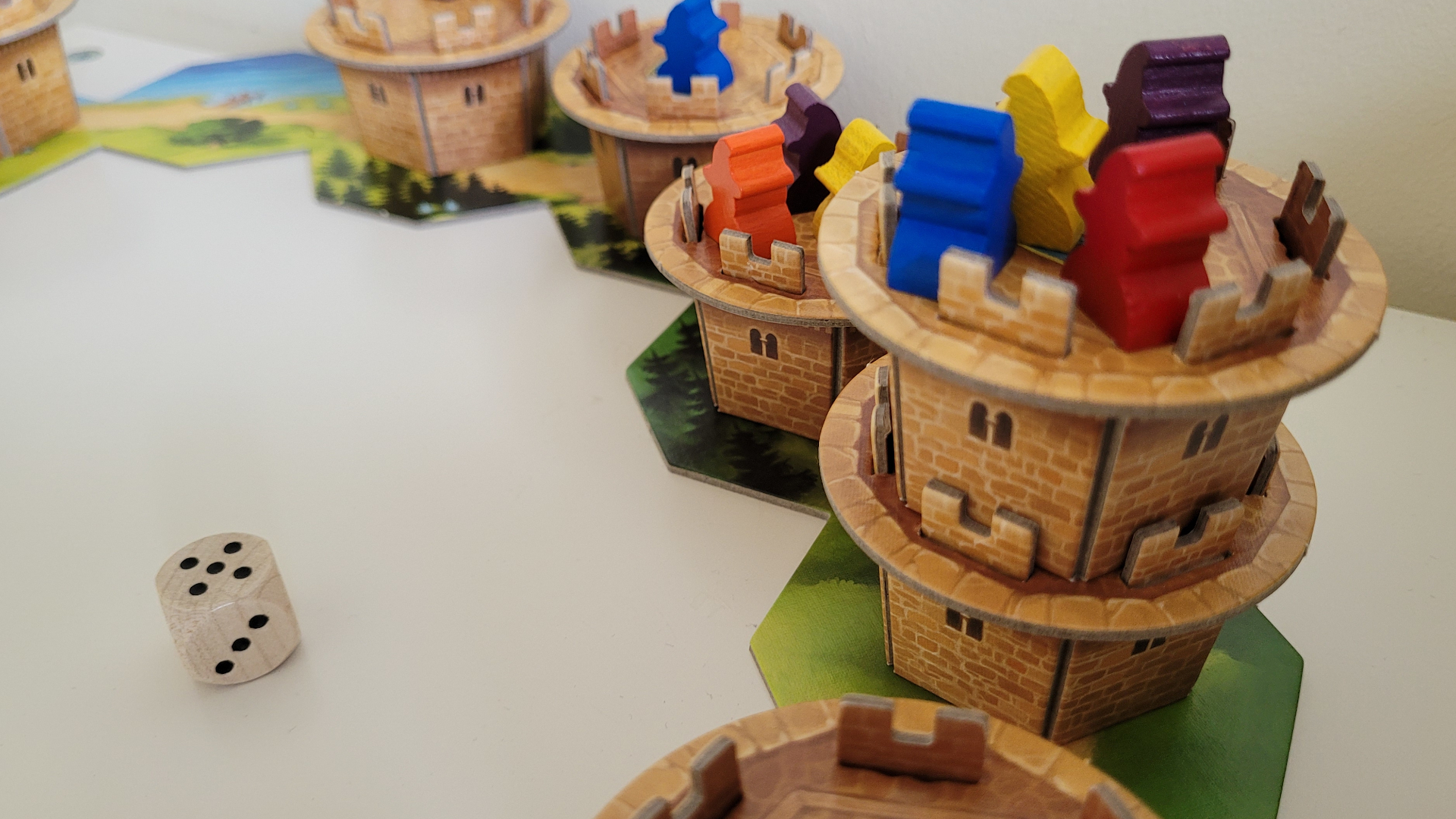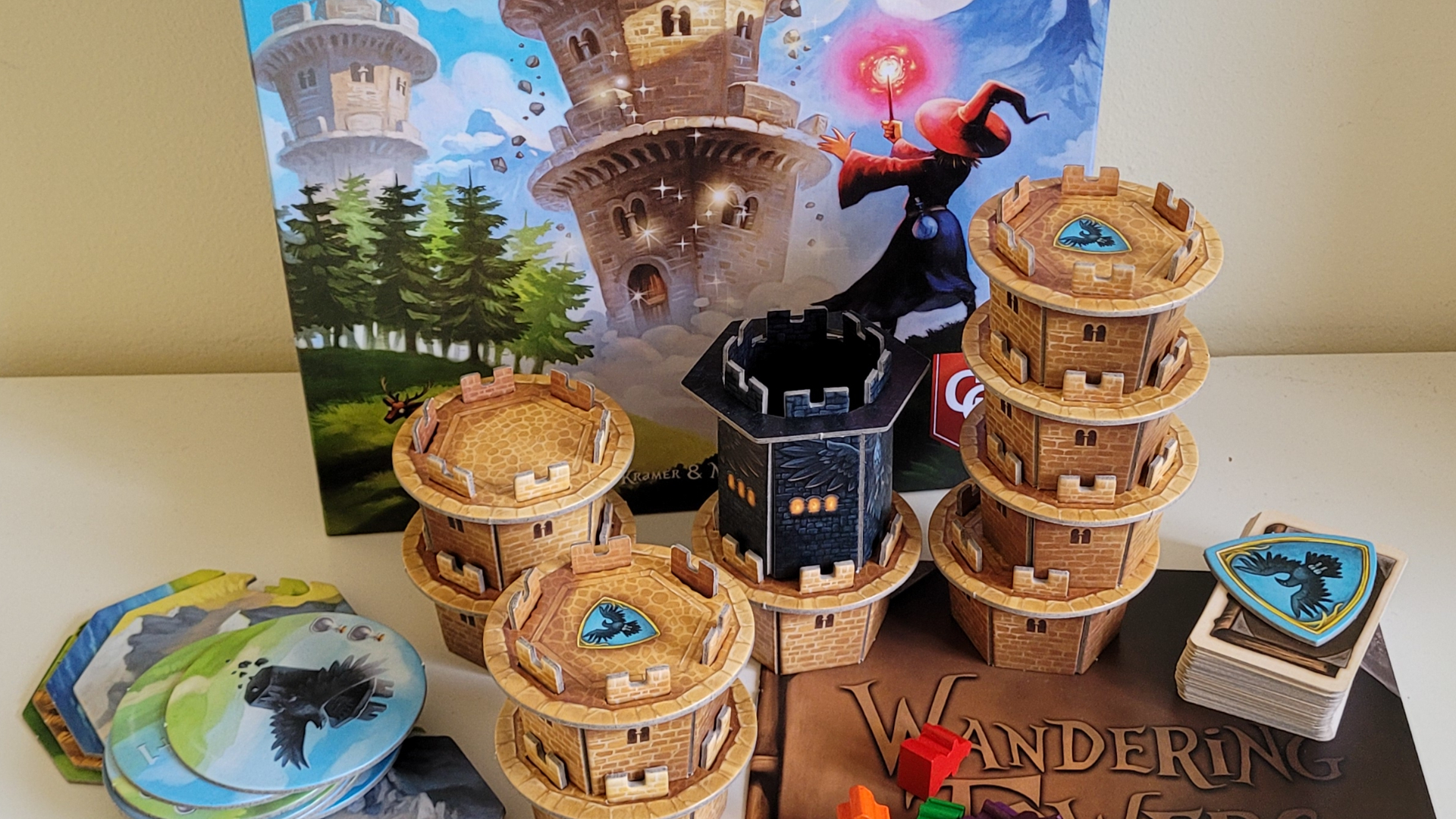GamesRadar+ Verdict
Under its accessible surface, Wandering Towers is a clever family game with a unique, whimsical approach. Even though it's not the most replayable, there's a lot more going on here than meets the eye.
Pros
- +
Family-weight rules lead to rich and ever-changing tactical decision-making
- +
Spells add depth and variety as you get familiar with the game
- +
3D cardboard towers look great on your tabletop
Cons
- -
Tactical focus reduces long-term replay value
- -
Included variants are largely worthless
Why you can trust GamesRadar+
Wandering Towers was mentioned repeatedly as a possible contender for 2023’s Spiel des Jahres, the biggest prize in board gaming. In the event, it didn’t make the shortlist, which came as a surprise. Its designers are industry veterans, with Michael Kiesling being responsible for the brilliant family-weight abstract Azul and Wolfgang Kramer the recipient of several previous Speil des Jahres prizes, including the stone-cold classic El Grande. It also looks great on the tabletop with stacks of 3D cardboard castles.
So, should you add Wandering Towers to your collection of the best board games? Let's dig in and find out.
Wandering Towers features & design
| Price | $49.99 / £49.99 |
| Ages | 8+ |
| Genre | Family |
| Players | 1 - 6 |
| Lasts | 30mins |
| Complexity | Low |
| Play if you like | Catan, Carcassonne |
- Play cards to move wizards and towers round the board
- Moving towers trap enemy pieces, creating potions for spells
- Victory requires filling a certain number of potions and getting your wizards home to an ever-moving target
At its core, Wandering Towers is a race to the finish. Your goal is to be first to get all your wizards into Ravenskeep and to fill all your potion bottles (the number of which varies with the number of players, helping to keep play time to around a half-hour). Just another Tuesday for a mage, in other words.
There's a twist, though. Those potion bottles are filled when you trap wizards underneath one of the 12 cardboard towers. To manage all this, you'll play a couple of cards each turn that allow you to move a wizard, a tower, or a choice of either the number of spaces printed on said cards. Because you have to move wizards an exact number of spaces to trap them, careful planning is needed.
Still, you'll be happy to pore over this board – Wandering Towers is a handsome game. It's both a mix of old and new; charmingly retro wooden meeples meet outlandish buildings made from cardboard, and it's all finished with an endearing cartoon art style.

As with so many good board games for adults, there's a degree of complexity under the approachable rules as well. Filled potions are not only a win condition, for example; you can also spend them to cast spells on your turn. The game suggests you start with the two most basic spells, which move a wizard one space or a tower two spaces. However, there are several more provided which do things like move pieces anti-clockwise, move Ravenskeep, or even peek beneath towers to find wizards. As you gain confidence with the rules, you can make more spells available, each increasing the strategic depth of the game.
On a similar note, it’s worth pointing out that Wandering Towers can be played with a number of variants out of the box. Solitaire it’s about getting all the wizards home to Ravenskeep in as few moves as possible. This mode can also be played cooperatively with a strict instruction not to discuss strategy to keep things spicy. There’s an optional “nasty” rule that lets you interrupt other player’s turns to stymie them by casting spells. Finally, four or six players can play a team variant, which allows teammates to swap cards and full potions.
Wandering Towers gameplay

- What looks like a simple race actually has a lot of tactical complexity with many interlocking elements
- While there are few random factors, so much changes between turns that it still feels exciting and chaotic
- Lacks long-term planning, which makes it accessible but limits replay value
When you first sit down to play Wandering Towers, you’ll have the mindset that this is a race game where you’re trying to get your wizards to the goal faster than everyone else. Moving towers has an obvious collective aspect because it’s difficult to get your wizards alone on top of a tower, so you’ll likely end up helping someone else. There are also times when you’ll want to take a suboptimal tower move, even one that doesn’t help your own wizards, in order to imprison other wizards and fill potions. So it’s a family-weight optimization exercise, basically, albeit one that looks fantastic on your table.
And it is all these things. But looking at the game through this lens is missing some vital aspects of play. The first is the way that Ravenskeep moves when a wizard ends up in it. If everyone is racing toward the keep, then it’ll move away from the chasing pack when this happens, making your goal harder. At some point, someone will realise that by moving towers and wizards, you can offer some control over where it’s going to move to. Shortly after, someone will realise that if you don’t move at all, Ravenskeep will eventually come to you. And at that point Wandering Towers reveals much of its majesty.
As you gain confidence with the rules, you can make more spells available, each increasing the strategic depth of the game
While your card draw is random, and some cards have a die roll of movement rather than a fixed number for a little extra excitement, the game is otherwise deterministic. So you have plenty of control over where your wizards go and which towers you choose to move. At the same time, there’s a whole range of tactical possibilities you need to cover. Are you best off moving wizards or castles? Can you trap enemy wizards? Do you have potions, and will the spells help? Will you, or anyone else, hit the keep this turn and have it move, and if so, how does it destination fit in with your plans?
At first, these are all straightforward things to parse – the kind you'd find in many family board games. But as soon as pieces start swooping around the track, the number of variables, and the enjoyment factor of the game, increase in line. The more players, the merrier things get, especially given the longer times between turns during which you can forget where your trapped wizards are. Because you can only dunk one wizard per turn into the keep, the game is almost guaranteed to give you a close finish, with everyone hooting and hollering and hoping to be the one who worked out the variables and rode the luck well enough to claim the prize.

Nonetheless, and as fun as it is, Wandering Towers does have one overriding issue – a lack of strategy. The game state can change so wildly each turn that there’s no value in a long-term plan: it’s all about making the best of your cards and dice and potions when your turn rolls around. These are good, crunchy, fun decisions, and their short-termism is a positive boon when it comes to family play, but they’re wholly reactionary. As a result, there’s little sense of development during or between games, and that missing feeling of building on your choices is a part of what makes people want to replay games.
Instead, Wandering Towers offers you variety with all its game modes. They’re a mixed bag. The solo and cooperative versions are rather soulless optimisation games. The “mean” version can be lots of fun with the right group, but it opens rules questions about exactly when, and in what order, players can use spells and introduces elements of kingmaking into play where one player can essentially decide which other wins. The team variant is the best, with the ability to swap around cards and potions adding to the tactical depth of the base game. Adding spells is another great way to spice the game up and dispel that sense of familiarity.
Should you buy Wandering Towers?

While Wandering Towers is good fun to play, that lack of replay impetus is unfortunate, and it carries a vague sense of not quite fitting into a distinct taste profile. It’s tactical without being strategic, interactive without being vicious, exciting while still being deterministic. But at the same time, this exact lack of easy categorization is a pointer to the fact that this is a clever, novel design with a lot more going on than it initially appears.
If that novelty arouses your interest, then you might well find this to your tastes alongside anyone who wants a cool-looking family game for their table.
Buy it if...
✅ You want a fast, family-weight game that’s a little more demanding than average
Ready to move on from the likes of Carcassonne and Ticket to Ride? Wandering Towers is a great step up to more hobby-grade board games.
✅ Your interest is piqued by novel games that defy easy categorization
Wandering Towers is pretty unusual, and that's a significant part of the appeal. Tired of the same old, same old? Give this a whirl.
Don't buy it if...
❌ You prefer heavier, less chaotic games with a lot of strategic depth
If you aren't a fan of games where you've got to roll with the punches and act based on what you've drawn at random, Wandering Towers probably isn't for you.
❌ You like to focus on a few games and play them a lot
Because there isn't endless replayability in this one, it's unlikely to become a staple of your game night sessions.
How we tested Wandering Towers
As with all review products on GamesRadar+, we played this board game multiple times to get a feel for its gameplay, longevity, and accessibility. You can find out more in our review policy, not to mention this guide on how we test board games.
Disclaimer
This review copy was provided by the publisher.
More info
| Genre | Family |
Matt is a freelance writer specialising in board games and tabletop. With over a decade of reviews under his belt, he has racked up credits including IGN, Dicebreaker, T3, and The Guardian.




